Many cold climate gardeners long for more growing days. This is especially true in extreme northern regions where you get a paltry 90 to 110 frost free growing days.
In our experience, it is entirely within the reach of the northern gardener to achieve considerably longer growing season. It’s not all just heated greenhouses, either!
This post details some of our experiments and thoughts when it comes to garden season extension in far northern gardens!
What Is Season Extension, Anyway?
Gardening seasons are typically defined, roughly, by the total number of frost-free growing days available to the gardener. In most cases, that season is defined from last frost in the spring to first frost in the fall.
First and last frost aren’t necessarily the only growing days available to the gardener. Commonly, there can be several weeks of good growing weather prior to and after those frost dates.
Season extension is the concept of exercising certain practices to artificially make that growing season longer.
Examples of season extension techniques include:
- Greenhouses
- Hoophouses (high & low tunnels)
- Cold frames (typically windows on top of raised beds)
- Heating methods (typically inside greenhouses)
- Frost cloth/remay cloth
- Growing frost-tolerant vegetables
As you might have gathered, the overall “point” of season extension is to warm ambient air temperatures, protect your plants and eliminate/reduce the risk of frost damaging your plants.
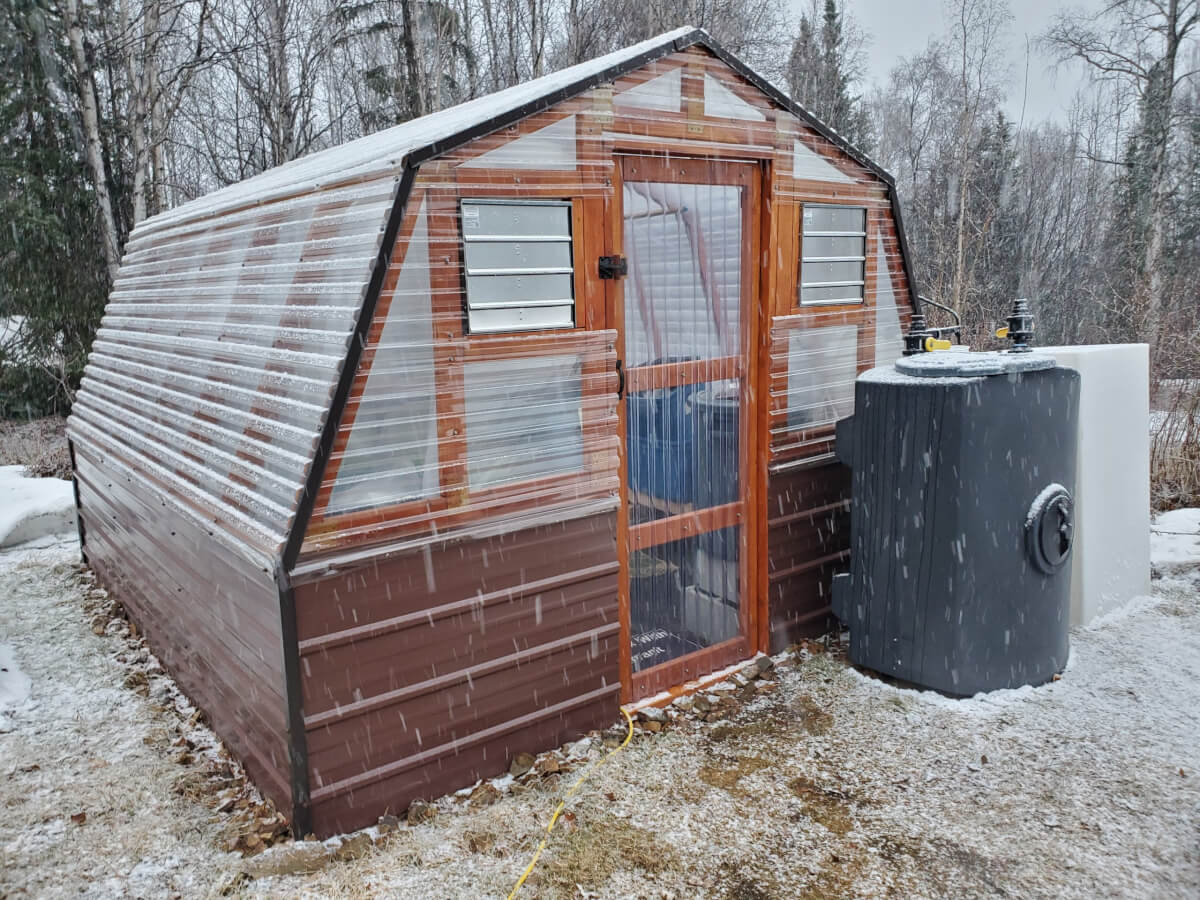
Using these techniques can offer the northern gardener several weeks of additional growing time. This time can often be had early and late in the season, sometimes offering over a month of additional growing time!
How Does Season Extension Actually Work?
At least in terms of greenhouses, hoophouses and cold frames, the way they work for season extension are largely similar to one another.
Since these structures are at least “somewhat” sealed off from the general outdoor environment, heat can be trapped. That heat comes from the sun during the day, which naturally warms up both the air and all mass within the structure.
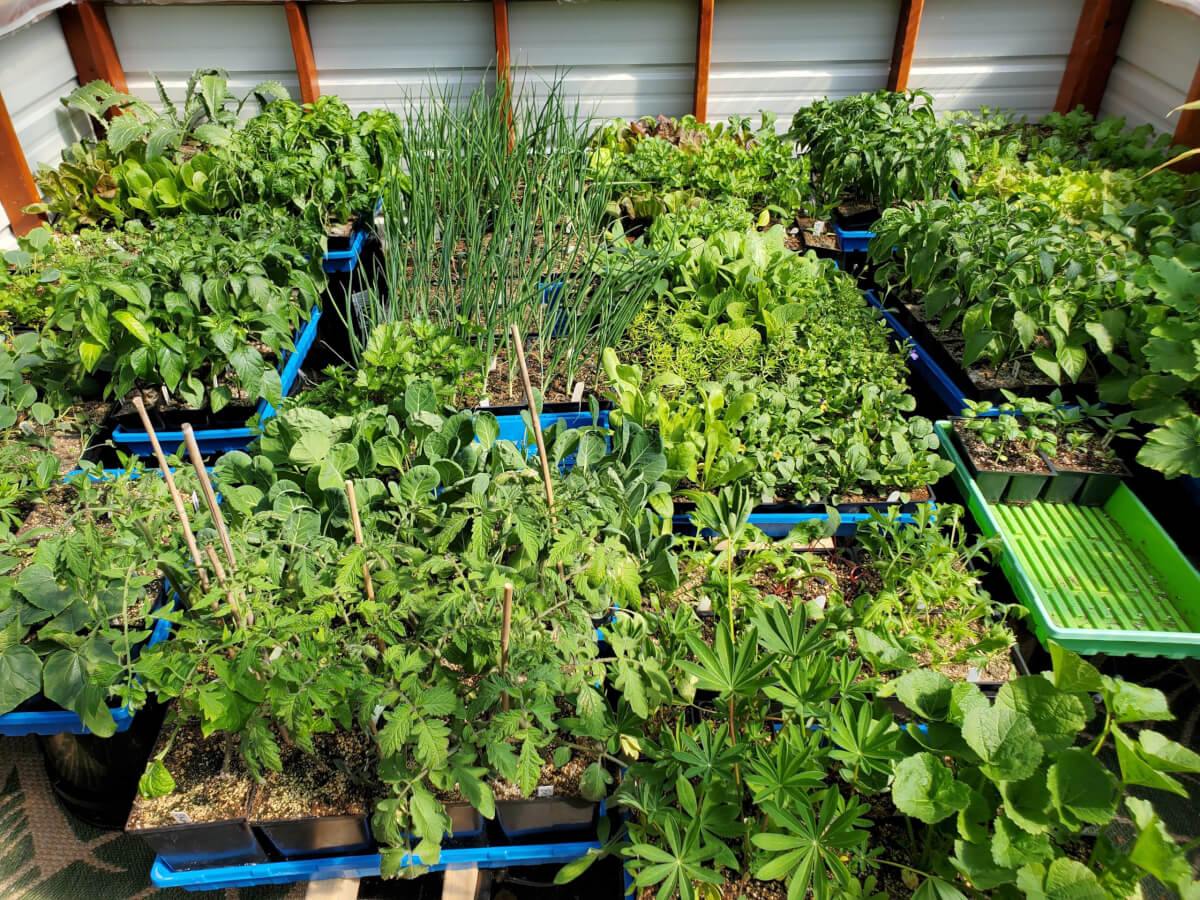
Photo showing our early season greenhouse and our entire season’s garden, well before dangers of frost have been lifted!
This warming, particularly the warming of thermal mass, will work to release heat when outdoor ambient air temperatures fall. This helps the structure retain heating over longer periods of time.
Since these temperatures are (ideally) above typical frost-forming temperatures, it works to reduce or eliminate the risks of frost.
We won’t leave out the other methods of season extension we talked about above, but these are a bit unique and need their own discussion.
The Practicalities Of Extreme Northern Season Extension
At lower latitudes, season extension is a very real thing. Many warmer climate growers can easily garden through the entire winter using season extension techniques.
This is not usually the case for most far-northern gardeners.
At a certain point, you can’t trap enough heat to prevent temperatures from dropping to dangerous levels.
Going further, the outdoor temperatures can become so extreme that it’s just not cost effective enough to combat those cold temperatures.
For northerners, the general goal is to try and get an additional growing month, or maybe two months in some extreme cases.
At a certain point, the cold weather rolls in and it’s no longer practical to continue gardening. The mind starts to wander towards wood stoves, hot drinks and cozy winter existence.
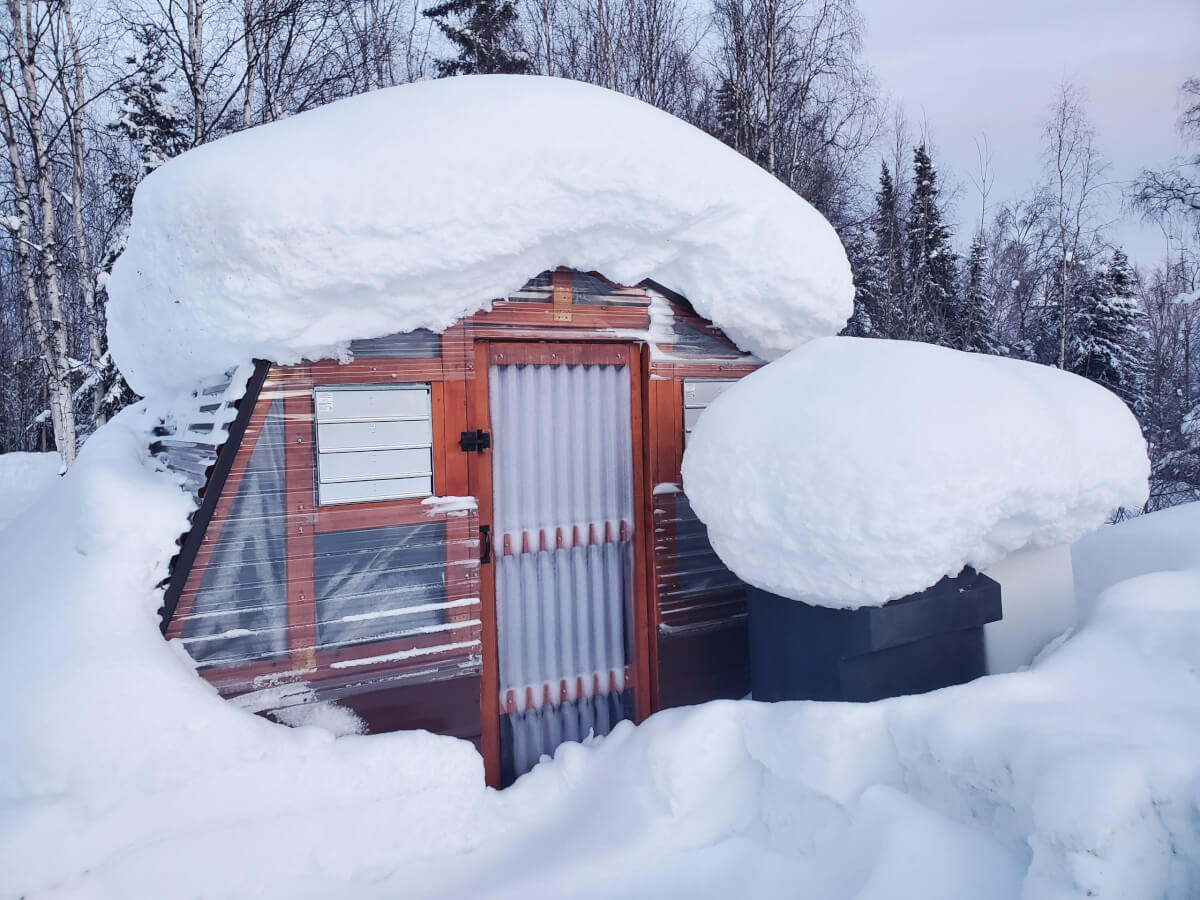
You are welcome to try growing food in these conditions, but we’d rather do other things. Indoor gardening is the best year round technique for growers wanting to practice winter growing.
However, this additional growing time can often open up additional varieties and crops that take longer to fully mature. It can also substantially increase harvest rates in some types of crops, a boon to the northern gardener.
Use More Layers To Increase Season Extension Capabilities
Above, we bullet-pointed the various techniques that can be used for season extension.
It is generally thought that a given protection technique can offer you approximately one additional “growing zone” in many cases. So, for example, if you’re in zone 4, a greenhouse would offer you roughly zone 5 growing capabilities.
This translates into growing time by offering the northern gardener approximately two to three additional weeks of growing in both the spring as well as the fall.
What’s cool is that you can use additional “layers” of protection, each providing that same additional bonus. Each additional layer can extend your growing season again by another two or three weeks.
Examples of this technique might be:
- Using cold frames inside of a greenhouse
- Using hoophouses inside of a greenhouse
- Cold frames inside a greenhouse
- Using cold frames in a hoophouse inside a greenhouse
- Double layer hoophouses
- Sealing a greenhouse with UV rated plastic
Now, this isn’t some “infinite life hack” where you add enough layers and all of sudden you’re growing in Costa Rica. There is a point where, absent external heat sources, outdoor and protected area temperatures will eventually equalize.
We sealed our greenhouse for exactly this reason. Besides building the greenhouse itself, this was the next best thing we’ve done to our gardens!
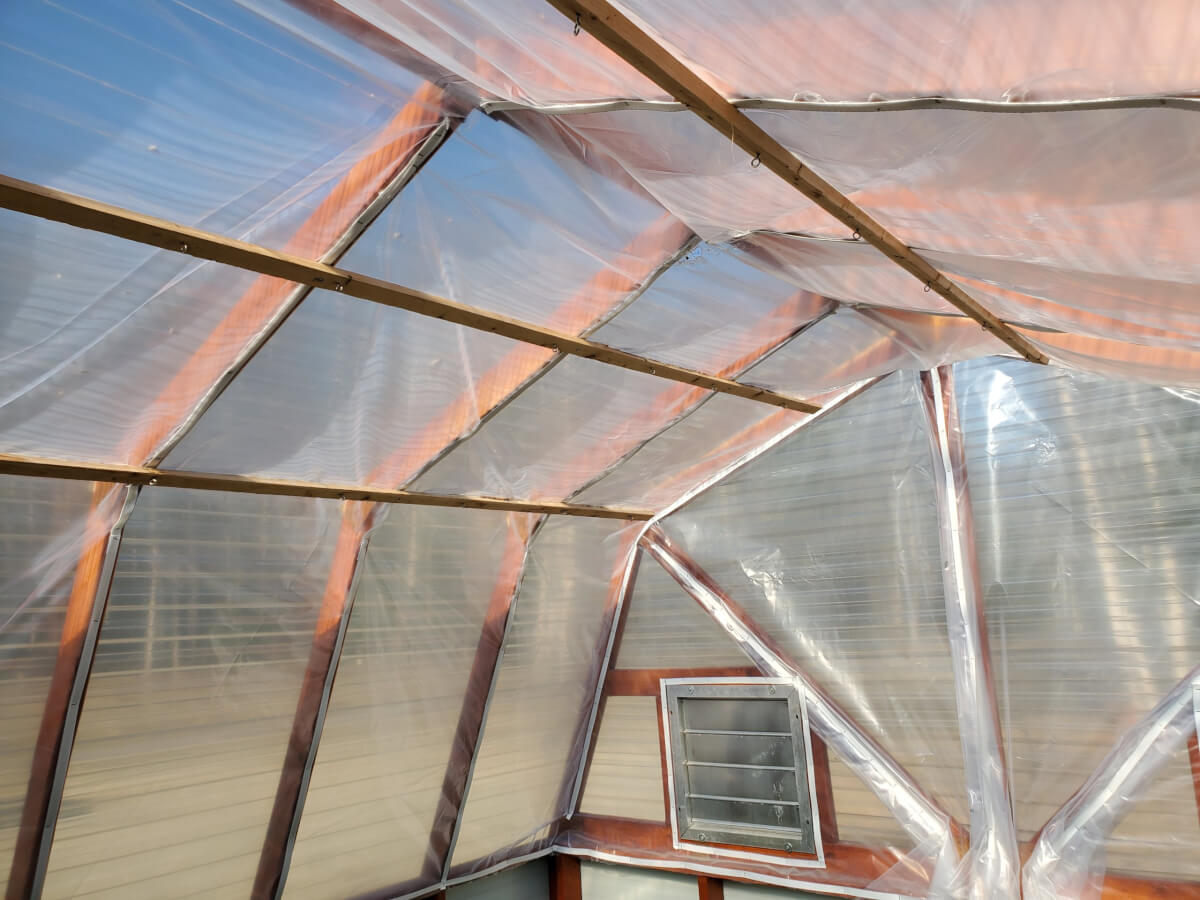
This shows the “second layer” of our greenhouse. We sealed our greenhouse with UV rated plastic. It was the best upgrade we’ve done, other than building the greenhouse to begin with!
The Reality Of Far-North Season Extension
You might have picked up that we didn’t specify “exact” amounts of season extension that can be achieved. Two, maybe three weeks. Ish.
The reality is that these techniques could offer an entire month of season extension. Some years, even more!
The “northern problem” is that this is going to be highly dependent on any given season.
Unlike more southern gardeners, there will come a point where outdoor air temperatures exceed the protection technique’s ability to provide more season extension.
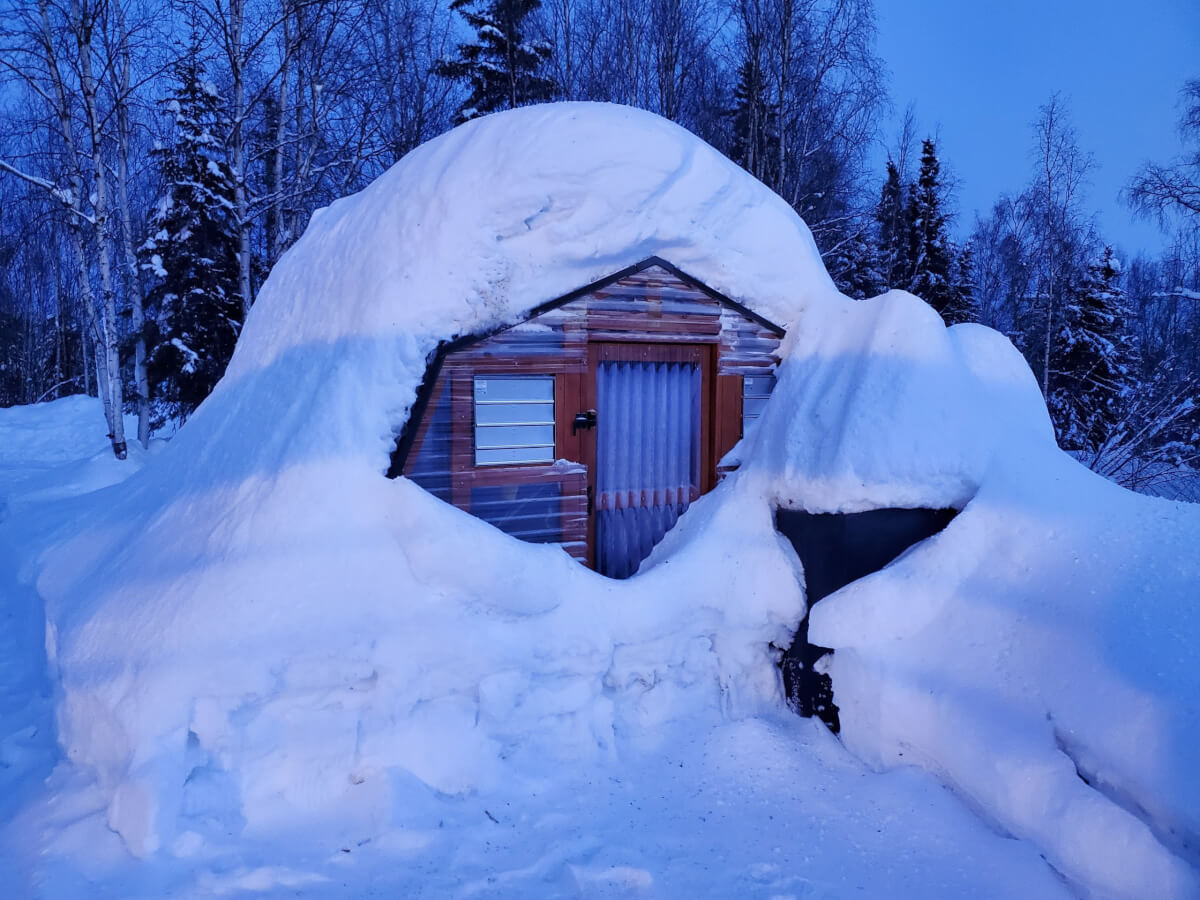
For example, a good “Indian summer” that extends well past first frost could easily result in an additional month (or more) of growing time. Conversely, unseasonal cold temperatures could roll in and thwart your season extension efforts.
These good or bad conditions are impossible to predict and as a result, the northern gardener must remain ever-vigilant during the shoulder seasons.
Season Extension & Plant Temperature Tolerance
We have discussed plant temperature tolerance in great detail, it’s a very important concept for the northern gardener to fully digest.
It also has relevance in season extension, as you might imagine.
What we mean by that is that season extension will naturally help cold hardy and frost tolerant plants more in the late season. You are likely to get longer general extension since these plants can tolerate lower temperatures.
One could generally expect the “upper levels” of season extension with cold hardy and frost tolerant plants. Meaning, roughly 3-4 weeks with one layer of protection and possibly up to 6-8 weeks with two layers of protection.
Warm loving and frost sensitive plants will be more susceptible to lower temperatures, especially the further into season extension you go. The ultimate answer is “it depends.” But, you can usually expect 2 to 4 weeks for one and two layers, respectively.
Season Extension, Naturally Done
One of the techniques we offered the northern gardener was to extend their gardening season by planting cold hardy crops.
The fortunate thing for northern gardeners is the overwhelming majority of commonly garden crops are cold hardy!
Cold hardy (and to some degrees, frost tolerant) crops feature amazing resilience to colder temperatures! They can handle the cold!
Mature, cold hardy crops can handle temperatures down to about 26 degrees Fahrenheit. In comparison, frost tolerant vegetables can handle temperatures around freezing (32F), perhaps slightly below.
This often describes the majority of fall in northern places like Alaska. Cold, sure, but not cold enough to kill a kale plant.
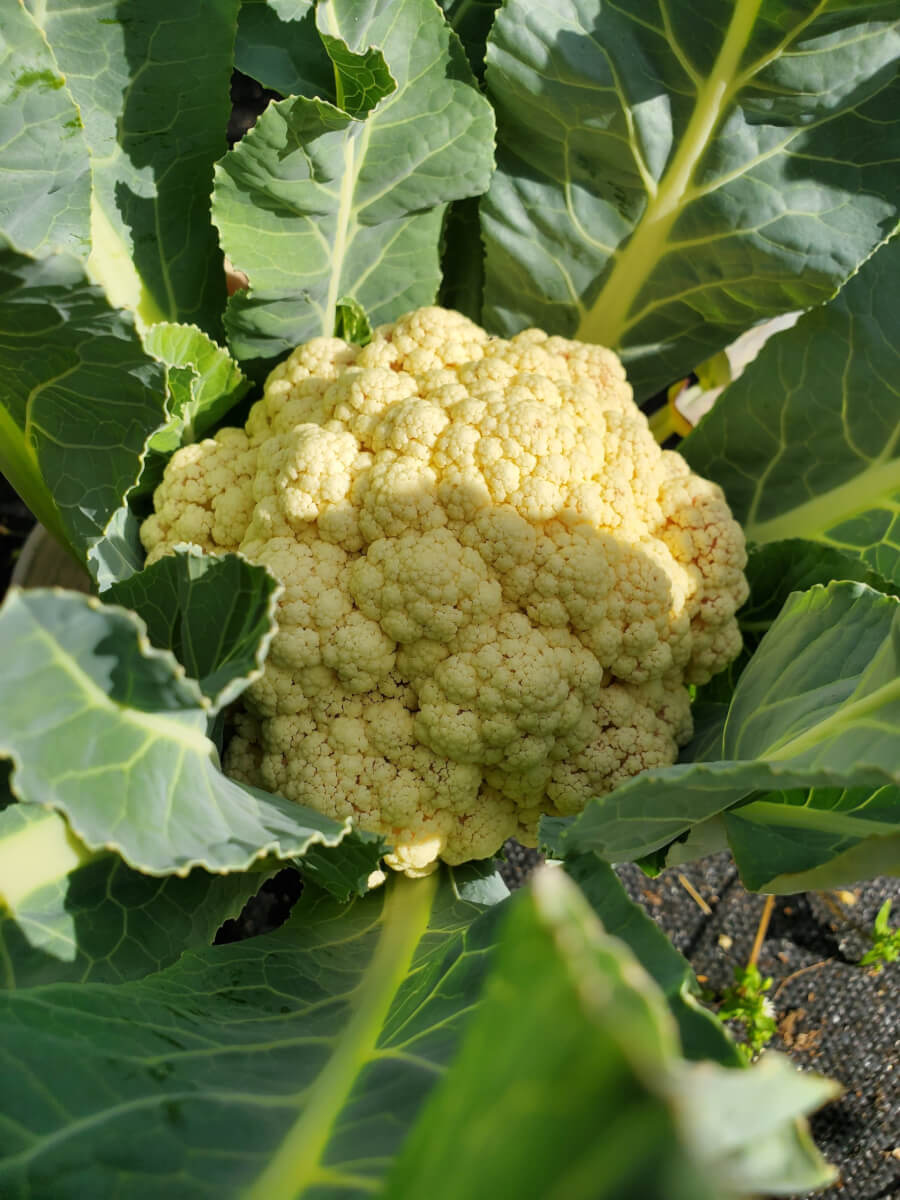
Cauliflower is among many other cold hardy vegetables that will naturally extend a cold climate grower’s season. Fortunately, the majority of commonly grown garden vegetables are cold hardy!
It is generally important to perform final harvests prior to what’s considered a hard frost. This would typically occur at those particularly low temperatures below 26 degrees Fahrenheit. Past that and you run the risk of frost kill.
Many root vegetables can handle much colder temperatures as well. So long as these crops are left in the ground, they can tolerate temperatures well into the teens and even below that!
Some years, we don’t end up harvesting some of our root vegetables until after the snow starts falling! These are usually our last priority.
We do generally advise harvesting and preserving root vegetables before the ground itself freezes. Frozen soils can damage your crops, which impacts longer term preservation.
Frost Cloth, Or Being Prepared As A Northern Gardener
We did include frost cloth as a means of generally extending the growing season.
Technically, it will do exactly that.
To us, having frost cloth on hand is more about being prepared for unseasonable frosts. It is an emergency counter-measure. But, at its core, it will protect your plants from settling frost.
We encourage northern gardeners to have enough frost cloth on hand to protect their frost sensitive and warm loving crops. Frost cloth is not something you want to frantically try to purchase the night you receive an unexpected frost warning.
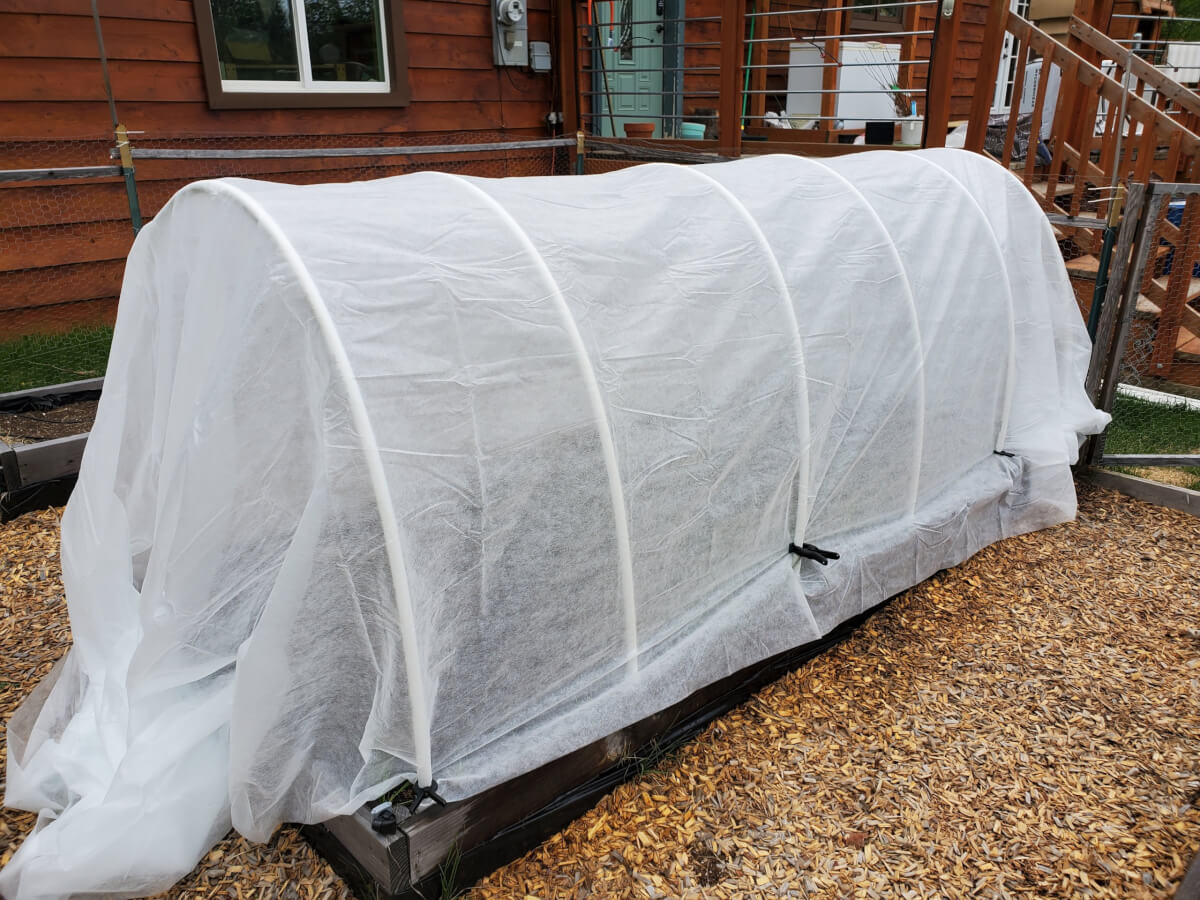
This is an example of how a gardener can deploy frost cloth over a raised bed. It doesn’t have to be complicated. Simply toss the frost cloth over your plants as best you can and they will be reasonably protected.
That said, you can use frost cloth to help your warm loving and frost sensitive plants survive the earliest frosts. Often times, this inexpensive measure can buy you another week or two of fully acceptable growing season.
It is a game of diminishing returns, though. Eventually, temperatures drop to the point where growth no longer occurs and it’s best just to harvest your crops and be done.
Early Vs. Late Season Extension
We have thus far generally conflated early and late season extension, or additional season during spring and again during fall.
These two points of garden timing do generally have different goals.
In the spring, we are typically raising our plants, getting them ready for their life and their future growth. In the fall, we are harvesting fully mature plants.
While you could use the season extension techniques in the spring to get some quick rotation crops in early (e.g. radish, spinach, mustards, leaf lettuce), most gardeners are interested in protecting their seed grown (or nursery acquired) plants from early demise.
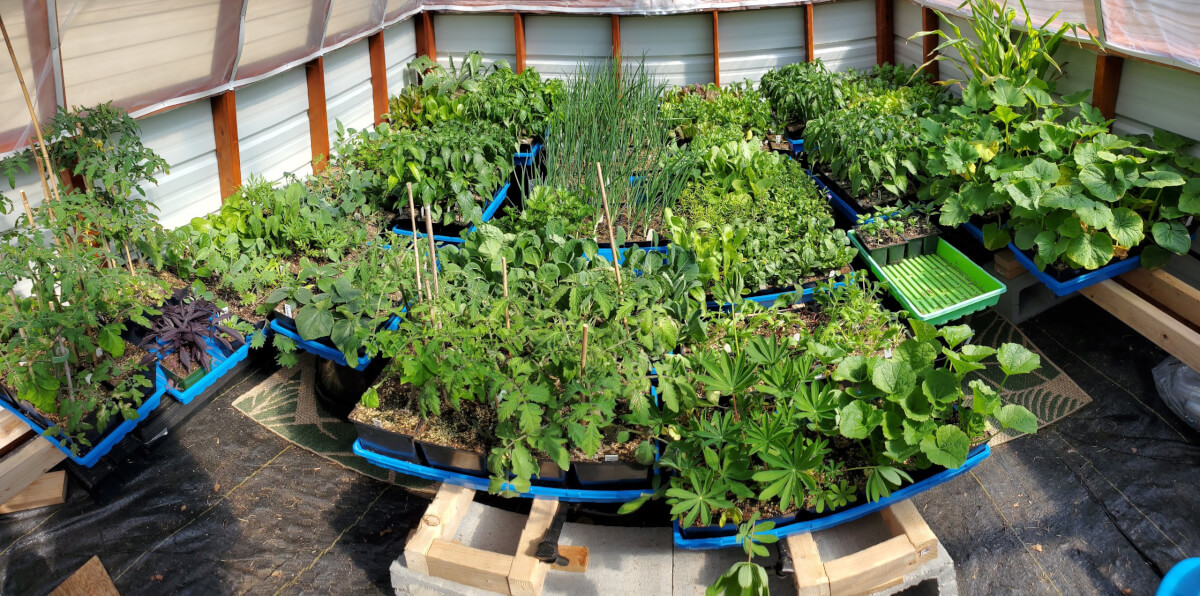
This is one of our season’s worth of garden starts, fully protected in our climate controlled (heated) greenhouse. We know it is capable of handling expected low temperatures.
We’ll talk about this further in the next section, because we do have some thoughts about it.
Season extension techniques are often most valuable for that fall period.
For example, if you can grow your tomatoes for three additional weeks, that could mean several more pounds of tomatoes for your harvest. An extra 2-3 weeks can mean the difference between fully ripe peppers or green ones.
Seedlings & Season Extension
A common need for season extension is for the “from seed” gardener to get their seedlings outside as soon as possible.
Indoor grow rooms are often quite cramped, especially later in the seed raising season and before transplanting season.
One of the most important things to keep in mind is that young, immature plants often have a lot less cold tolerance than their fully mature and grown counterparts.
You might need to pay extra special attention to expected evening low temperatures.
The greenhouse or hoophouse is not a miracle, allowing survival under all conditions. If the conditions for frost are met in your greenhouse, even seedlings in a greenhouse can die.
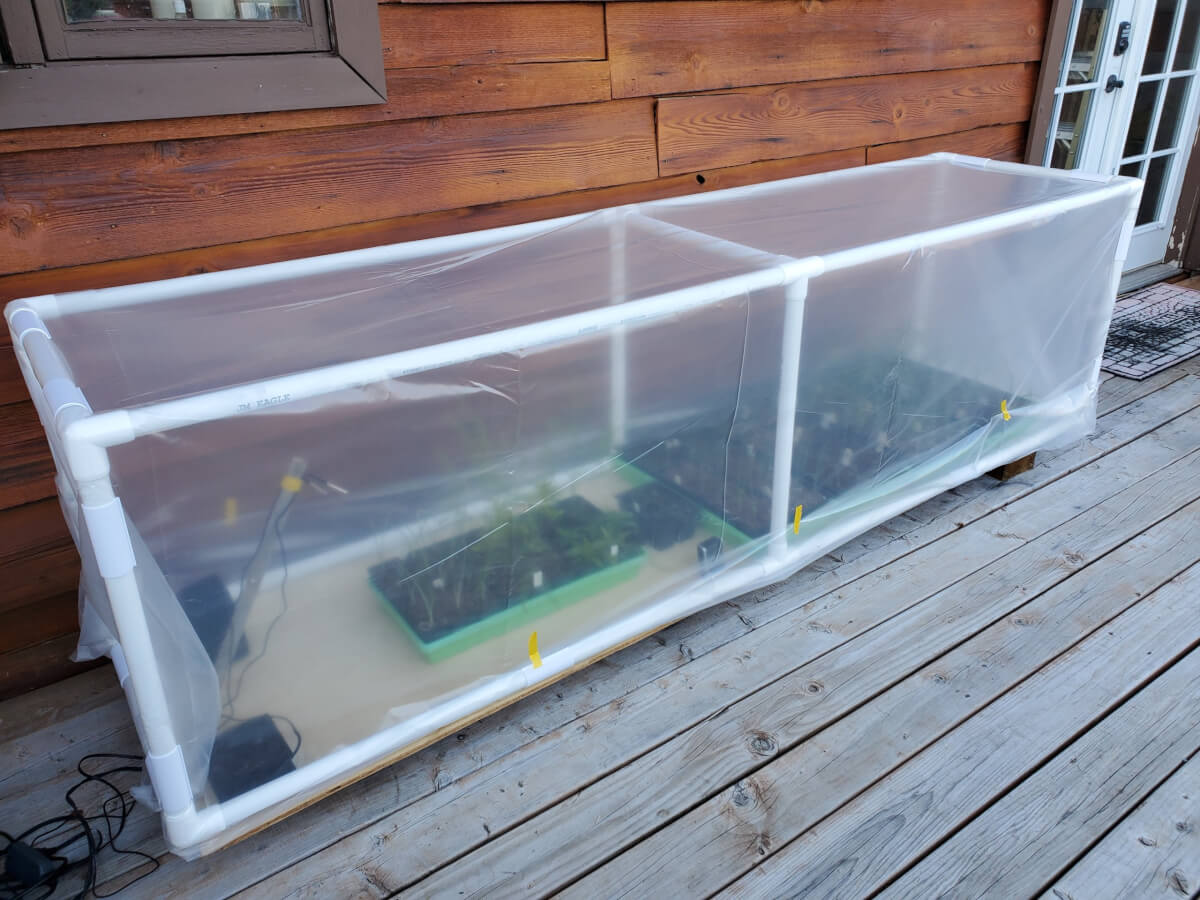
This is an example of an inexpensive, DIY “greenhouse” that is fabricated out of UV rated plastic, PVC and fittings. It is fully temperature controlled, capable of surviving even direct snowfall.
We generally provide some advice about this in our article on aggressive subarctic seedling handling.
However, early season is one of the best times for applications of heat in the protective structure. If you can guarantee that frost and particularly cold temperatures will not be experienced, the greenhouse or hoophouse can be an excellent place for young seedlings.
Using Heat For Season Extension
Using an external source of heat is one of the most reliable ways for the northern gardener to protect their crops and achieve maximum season extension.
We have found this particularly true in early season extension, where we might want to place our seed grown garden starts in our greenhouse.
It’s important, should you go to do this, that the structure be relatively air tight. If there is free exchange of air, your heating mechanism will largely be lost. No one wants to pay to heat the outdoors!
Also, the more efficient and air tight your protection methods are, the less your overall heating costs will be.
In our two-layer 10×12 greenhouse, we are very easily able to heat against ambient air temperatures of around 20F with a mere 1,500 watts, using a space heater.

This is our heating system for our 10×12 greenhouse. We use temperature controllers and two heaters (for redundancy) to maintain minimum low temperatures that are above frost-forming temperatures.
If you have a large structure, you may need to pursue more powerful forms of heating. Gas based systems (propane, etc) are often good choices, but can sometimes be difficult to precisely temperature control. You may also need internal fans to distribute that heat effectively.
Some people have installed wood stoves in their greenhouses. This allows the gardener to start a small fire and rely on the wood stove’s heat distribution throughout the lower evening temperatures.
Lastly, remember, thermal mass is your friend. If you can heat up thermal mass through the day, that’s less work any given heating system will have to make up for during the evenings.
More Favorable Climates Feature More Possibility
This article is largely written from the perspective of USDA zone 2 and around there. Here, we’re trying to survive 30 to 50 below zero winters.
When you start to look at USDA zones 5 and above, the concept of “year round gardening” does become feasible. Difficult, but feasible. This would be regions with annual low temperatures that don’t exceed -10 to -20F.
In these zones, you can combine some of the cold hardiest plants (e.g. kale, lettuce, mustards, etc.) and multiple protection layers (typically three or more) to achieve harvests throughout the winter.
If this applies to you and you’re interested in pursuing it, these are some of our brief thoughts:
- Three layers would likely be greenhouse plus low tunnel plus cold frame (or double layered hoop house inside a greenhouse)
- Check plants minimally and preferably on warmer days to prevent cold shock
- Don’t expect rapid growth, like you would in summer
- Keep the greenhouse clear of snow to maximize thermal input
We’ve seen this very practice done. It’s definitely not for everyone, but it is technically possible.
Our Comments On Northern Geothermal Heating
A popular idea, typically at lower latitudes, is to use geothermal heating techniques for greenhouses. We’d offer the northern gardener a bit of advice here, prior to making an expensive mistake.
Geothermal heating is not as straight forward in the far north. With frost lines that often extend four feet or more beneath the ground, they take an immense amount of excavation to make them effective.
They are also very difficult for the average homeowner to calculate the necessary air exchange rates for an effective heating application. Even one as simple as a greenhouse.
Unless you happen to live near a hot spring or naturally heated fissure, geothermal will be the most expensive possible way you could achieve greenhouse heating in northern regions.
It would be more wise to put your money into a more capable greenhouse structure. Advanced materials, such as 5-layer greenhouse panels, will do far more for heat capture and retention. This could then be much less expensively heated, using more reasonable and traditional heating systems.
Season Extension Is Where It’s At In The North!
We have seen some amazing benefits to our pursuits in season extension, growing in the far north.
While we’re not likely going to be growing all year long anytime soon, achieving just one more solid month of growing season has been enough to satisfy our production needs across many areas of our gardens.
We hope this post has provided you some insight into our thoughts and processes. As always, should you have anything to add or thought of a question, we’d love it if you slapped a comment down below!
That’s All We Wrote!

Having a good time? We have an ever growing list of insightful and helpful subarctic & cold climate gardening articles, waiting out there for you!
- Cold Climate Gardening Basics 👉
- Growing Your Garden From Seed Indoors 👉
- Advanced Cold Climate Gardening Techniques 👉
- Plant Specific Cold Climate Growing Guides 👉
- Subarctic Perennial Food Forests & Foraging 👉
- Indoor Garden Lighting & Grow Rooms 👉
- Greenhouses & Temperature Control 👉
- Harvesting & Food Preservation 👉
- Solving Cold Climate Garden Problems 👉
- 1 Minute Reads On Tons Of Garden Topics 👉
FrostyGarden.com is 100% ad-free and we do not use affiliate links! This resource is voluntarily supported by our readers. (Like YOU!) If we provided you value, would you consider supporting us?
